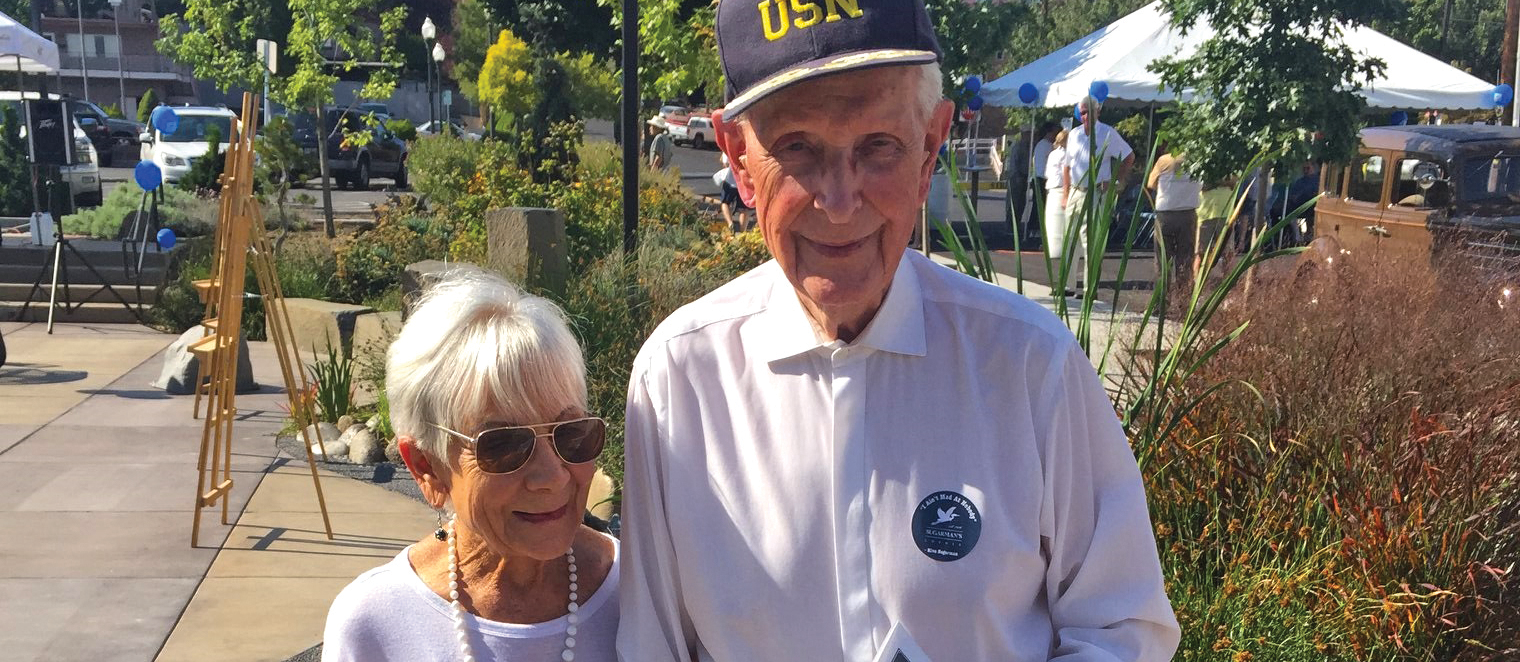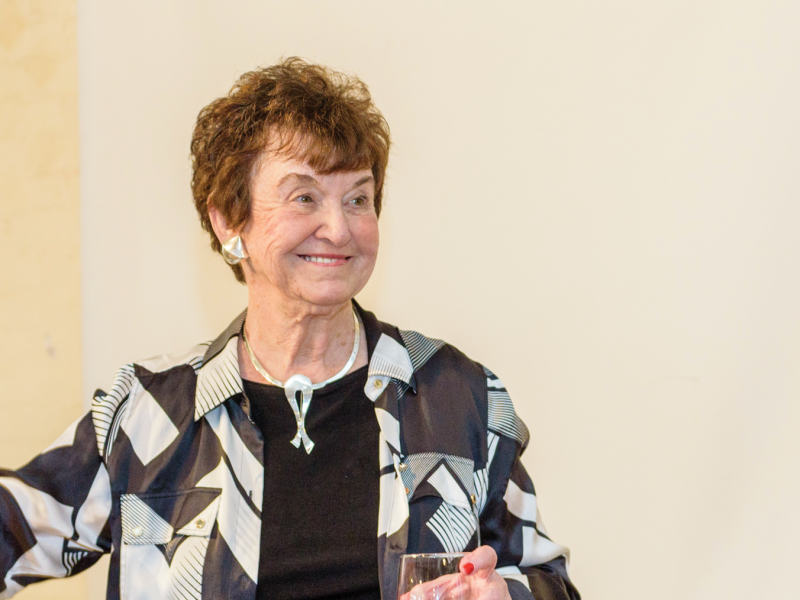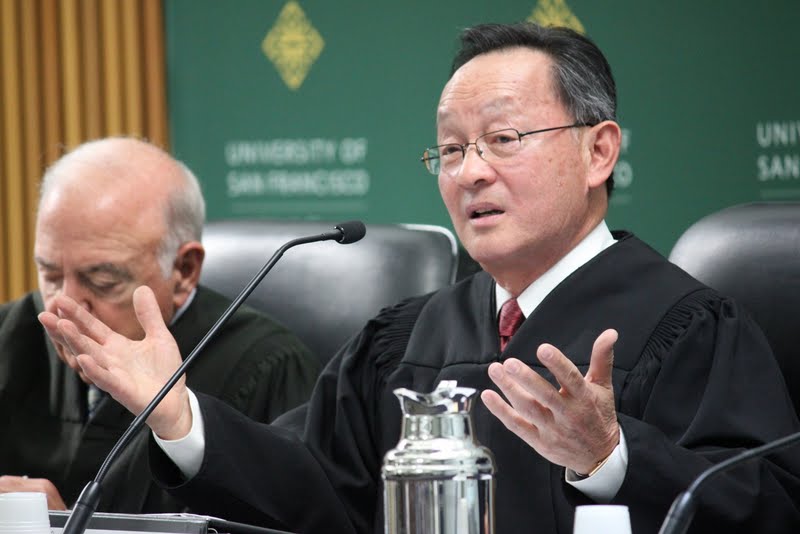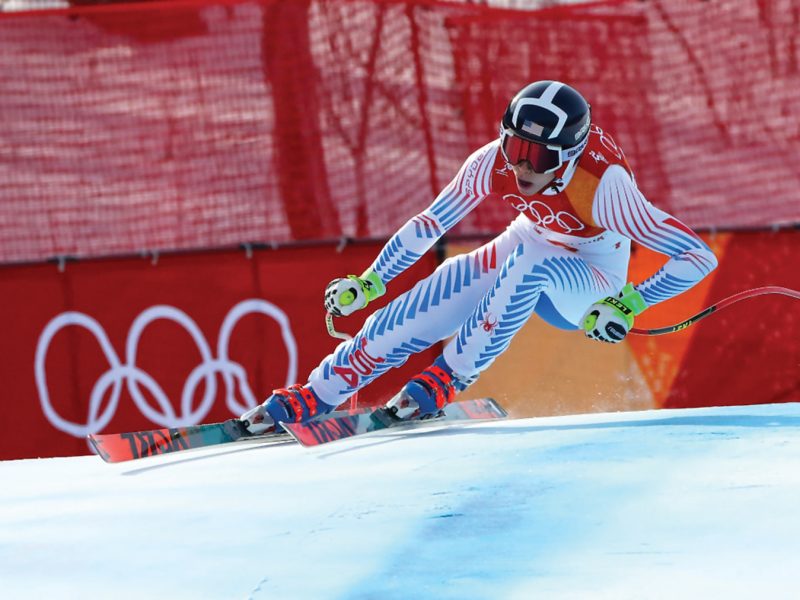The Klamath Basin is home to little towns filled with big hearts. The Klamath Community Foundation salutes our hometown heroes who show us how Klamath put them on the road to great achievements. Because the big world starts in a small town.
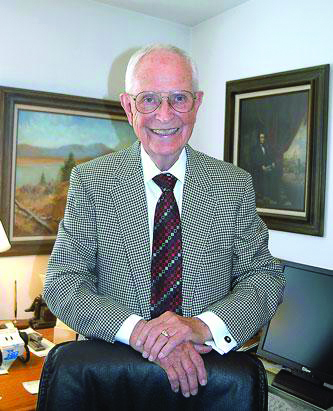
On Labor Day 2018, more than 100 people gathered at Sugarman’s Corner in downtown Klamath Falls to reflect on the contributions of early Klamath pioneer and haberdasher, Kiva Sugarman, who “helped build schools, streets, public buildings and community necessities.” Among the crowd sat well-dressed, 98-year-old Jim Stilwell, who frequented Sugarman’s Department Store as a young man. Sugarman once praised Stilwell, telling him his name was “as good as cash.” That compliment “did something for me,” Stilwell said. “It gave me pride.”
I grew up next door to Jim Stilwell. He was the most dignified, sartorial person in the county as far as I was concerned. There wasn’t a person on the block that wouldn’t agree he rode tall in the saddle – which in this case was atop the big red tractor he broke out following every snow storm. After meticulously plowing the road, he’d push the snow to the top of our hill where a dozen kids would arrive with sleds.
Jim set a high bar in all things, but particularly in lawn care. The entire neighborhood called his front lawn “Cow Hill,” which was curious since I’d never once seen a cow there. But I guess there used to be a number of them, which tells you it wasn’t a small front yard. Despite the size, his lawn was lush and mowed and served as a ubiquitous reminder to maintain one’s yard.
There were plenty of things my six year-old-self found noteworthy about Mr. Stilwell. For example, it seemed oxymoronic that the whole neighborhood called him “Jim Boy” when he had the most striking shock of white hair and almost always donned a suit. There was the time he introduced us to his vintage slot machine and then explained what a stock dividend was, which had my head spinning as fast as the reels on his one-arm bandit. He took us to his Spring Creek cabin where we hunted for Mare’s Eggs and Indian Paintbrush. Afterwards we drank mocktails while Jim Boy caught up on his stock market report. I remember thinking that you have to stay on your toes when you’re with Mr. Stilwell.
Years later I moved back to my hometown and saw my smartly-dressed neighbor at a party, still sharp as a tack. We reminisced about the place where we both grew up and made a date to tour the town.
On the day we drove down memory lane, I arrived at Jim Boy’s house in a freshly cleaned car expecting to chauffeur him. But Jim held tightly to the reins and opened the passenger door for me. Driving a tick or two beneath the speed limit, we rounded the Southside Bypass and entered our hometown from Green Springs Drive.
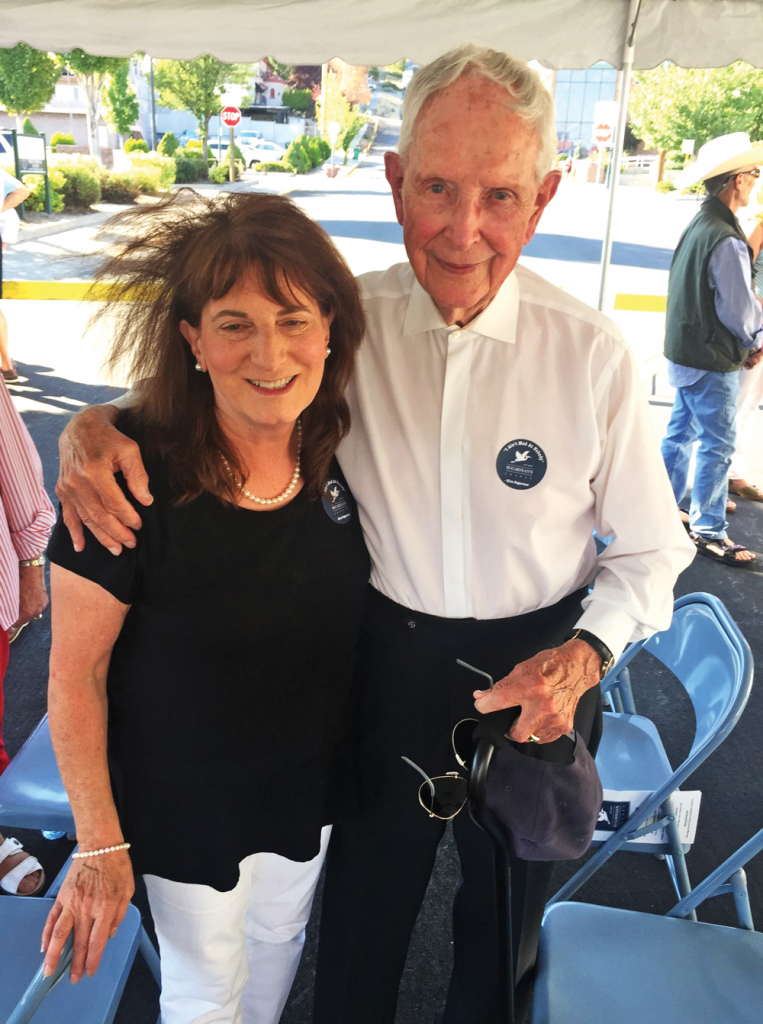
Jim pointed out Mr. Sloan’s apple orchard growing on the hillside and noted it was “there 87 years ago. His daughter Rosemary was my classmate.” We passed the grand old houses once occupied by “the Great Northern [Railroad] officials,” drove past the old Baldwin house (“George was a friend”), gave a nod to George Nicholson’s childhood home (“he became the dentist”), and stopped briefly at the site of Jim Boy’s first Klamath home on the corner of Riverside and Main Streets. Today it’s Sargent’s CPA office.
There Jim told the story of how his family arrived in Klamath during a 1931 blizzard. Despite the bad weather, they bought pork chops at the market and cooked them on a camp stove.
We reentered the highway heading for the site of his next home at Pelican City. “When I was a kid, we called this Rabbit Flats,” he said looking north on Highway 97 near Cove Point. Turning past the old Pastega Market, Jim Boy swore that, “Pastega imported the best salami…but we couldn’t afford it.” He told of Harold Mortenson, the manager of Pelican Bay Lumber Company and how every year Mr. Mortenson would buy a baseball for the neighborhood boys.
Heading up Lakeport Boulevard, Jim Boy passed the old Catholic cemetery and turning onto Beihn Street said, “This is the old highway, did you know that?” “No,” I reluctantly admitted. Some forty years later and I still have to stay on my toes with this guy.
But acknowledging that the highway was re-routed doesn’t necessarily mean recognizing that there’s now a new protected bike lane on Oregon Avenue. We drove straddling the paint lines which, given the early controversy surrounding the bike lane, makes his show of civil disobedience, to some, heroic.
Pulling onto Main Street, Jim Boy paid tribute to Klamath’s good ‘ol days like only the best time-traveling tour guides can do. “Back in the day we had 12 gas stations on Main Street and gas was just 16 cents a gallon.”
That triggered us to count the number of grocery stores downtown, which included the Piggly Wiggly and the Palace Market where my guide worked as the Butcher Boy. He made deliveries wearing a white coat and told of once receiving an extremely generous $5 tip from the madame at the local house of ill repute. There were also a number of drug stores including The Square Deal, Star Drug, and Underwoods, which eventually became Walgreens in 1937. That led Jim to proudly exclaim that Klamath was at that time “the only small town in America with a Walgreens!” A quick glance at an old Evening Herald newspaper indicates that Klamath’s finely appointed Walgreens was indeed the first in Oregon.
Driving past 500 Klamath Avenue, Jim recognized the importance of philanthropy by mentioning that “the Daggetts gave us the library.” I looked at what is now our City Hall building and felt wistful for a day I’d never known. But you get the sense that the soft-lens of nostalgia doesn’t make Jim Stilwell overly sentimental. This is a real estate man for whom shuttered storefronts hold promise. Loving your hometown doesn’t just mean making peace with the changes that happen over time, it means making some of that change happen. And that’s something Jim Stilwell knows a fair bit about. Afterall, he developed numerous business and building projects throughout the Basin and brought Klamath its first shopping center.

But without a doubt he is most proud of his work on the hospital. The story goes that in 1961, Greer Drew, another great Klamath haberdasher, asked Jim to chair an unprecedented capital campaign to build the new Presbyterian Intercommunity Hospital. Drew called the need for a new hospital critical, even though Klamath already had two hospitals.
To some old timers, two hospitals must’ve seemed enough. Sixty years prior, Klamath had no hospital, just a “lying facility” operated by a nurse in her home on 11th Street. One historian said, well, “it was near the cemetery.” By 1915 there were more than 40 mills in Klamath County and the jobs were dangerous. So timber companies awarded physicians exclusive contracts to serve millworkers. The Klamath Valley Hospital on Pine Street, opened in 1920 with a brand-new Cadillac ambulance from Los Angeles. In 1928, Dr. George Merryman received backing to build the Hillside Hospital on the corner of Pacific Terrace and Crater Lake Parkway. By 1939, a number of local doctors wanted out of their timber company contracts and formed a physician insurance program called the Klamath Medical Service Bureau (KMSB). In 1946, KMSB purchased both hospitals.
Such was the state of medical affairs when Greer Drew pressed Jim to help lead this critical campaign.
The new hospital would cost $2,958,000. If they could raise $725,000 from the community, then they could secure the balance from federal Hill-Burton Funds and a $900,000 mortgage. To put this in perspective, in today’s dollars that hospital building cost over $25 million and the down-payment was the equivalent of more than $6 million. In its 100-year history, some great things had happened in Klamath, but nothing like this.
Being asked to head up a campaign to raise that much money must’ve been like making plans to have dinner on the moon (and Neil Armstrong didn’t do that until 1969!). Most men would’ve walked from the challenge, but Jim mulled it over until Joe Hicks, fellow pilot, friend, and head of KMSB, assured Jim it couldn’t be done. “This was what I needed to hear,” said the new General Chairman of the Presbyterian Intercommunity Hospital Construction Fund Campaign — nicknamed “Project Remedy.”
Project Remedy officially began March 13,1963, and ended with the opening of the new hospital’s doors on October 10, 1965.
Jim Stilwell led an intense, 15-month fundraising effort that caused him to step aside from his “real job.” But he stood shoulder-to-shoulder with local giants like Andy Collier, Dick Henzel, Mike Balsiger, and “the group of women who each month brought their meager Social Security checks into my office.” Rumor has it he even borrowed from the bank to pay his pledge to the hospital campaign. Webster’s calls that commitment.
The General Chairman’s team galvanized some 800 volunteers, including more than 400 Women Crusaders. The February 24, 1963 Herald and News, described the mission of the Crusaders as bringing “the story of the proposed new hospital to every home in Klamath Falls… and answer[ing] any questions that citizens in Klamath Falls may have regarding the construction and financing of the hospital.” In the same article, “Stilwell said that the citizens of Klamath Falls and the Klamath Basin face a critical test…can the community pull itself up by its own boot straps, raise the funds to build a critically needed new hospital, and prove that the Klamath Basin is once more moving ahead?”
The March 13, 1963 Herald and News reported that volunteers constructed a hospital booth in the Balsiger’s Auto Showroom giving “Basin residents an opportunity to see actual equipment to be used in the new hospital in action.” The 408th Fighter Group at Kingsley Air Force Base staged a Mardi Gras Variety Show and spaghetti dinner to net $3,240 for the cause. The Normadean Dance Studio performed “Eliza and the Lumberjack” as a benefit for the hospital fund. And Otto Hall smiled as he handed the General Chairman a $1,000 check on behalf of the International Woodworkers of America Union Local 3-12.
Project Remedy leaders had a plan, and it required aggressive corporate requests. They solicited our two national banks but were disappointed to receive rather modest donations. “We knew we must establish a basis for contributions from corporate entities, Stilwell said. “We knew if we accepted these amounts, from major donors, the project would fail. We returned the checks with a well-written letter, signed by community leaders and promptly received checks for two and a half times the original amounts. This took courage.”
Indeed. It took courage, gumption, and grit. The same attributes shared by the pioneers who founded Klamath Falls, and which many of our residents still exhibit today.
Over the years the hospital has changed, and not just its name. It’s added the cancer treatment center, the day surgery wing, a community education center, the family birth center, the kidney dialysis center, and a major upgrade and expansion of its emergency department. It’s built the OHSU-Cascades East Family Medicine Residency and a 100,000 square-foot expansion of 50 private and 17 semi-private rooms in front of the original hospital. Soon it will open the doors of the new four-story Collaborative Health Center with 126 exam rooms, laboratory and diagnostic imaging services, and dedicated academic space. But none of that would be possible without Project Remedy.

Unquestionably, the realization we have a hospital is my proudest achievement. I have been richly rewarded to have worked with such generous, caring people. This hospital is truly “By and For Our People.” The new medical center is possible because of the investment — the generous support in time and talent and yes, financial donations — of people in all the communities we serve — the investment of “self” that makes us who we are, that makes the Klamath Basin so special… It is not just for the present, but also for those to follow. We may benefit from the past, but we live and plan for the future. –James F. Stilwell, Oct 14, 2015
General Chairman, Jim Stillwell called on his fellow citizens to help pull our beloved hometown “up by its own boot straps.” That’s something he’s done his whole life with great success. Having lived through the Great Depression he was never too proud to take a job as a paper boy, or a delivery boy, or a lumber truck driver earning just 75 cents an hour. Prevailing over his hardscrabble youth has given Jim self-respect, dignity, and pride that’s well-deserved.
In the middle of his historic Project Remedy campaign, the December 8, 1963 Herald and News reported that, “Stilwell urged greater pride in community. We’ve got everything here. Let’s start talking about it.” He was right; pride of place is important.
My well-dressed neighbor said last Labor Day that when Kiva Sugarman told him his name was “as good as cash,” he felt a sense of pride. In the face of all you’ve given this community Jim Boy, seems to me your name is as good as gold.
Heidi Neel Biggs is Executive Director of the Klamath Community Foundation and a member of the Sky Lakes Medical Center and Klamath Works boards.
Written by Heidi Neel Biggs


